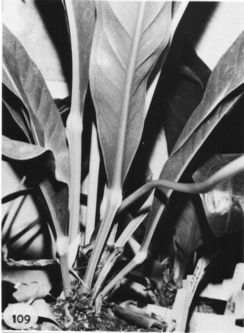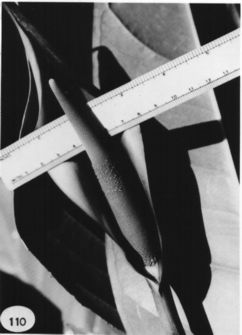





Anthurium luteynii Croat,
Selbyana 5: 324. 1981. TYPE: Panama. Veraguas: Río Primero Bra-so, 2.5 km beyond Escuela Agricola Alto Piedra, beyond Sante Fe, 700-750 m, Croat 25521 (MO 2827506-08, holotype; B, CAS, F, K, NY, PMA, SEL, US, VEN, isotypes; Live at MO).
Rosulate epiphyte or terrestrial in deep humus; internodes short; roots woody, brown, descending; cataphylls coriaceous, 10-23 cm long, minutely apiculate and inequilateral at apex, drying tan, the apex remaining intact as reticulate fibers, subpersistent.
LEAVES held nearly erect; petioles 9÷45 cm long, 1.5-2.5 cm wide, sharply sulcate, more or less trapezoidal in cross-section, the abaxial surface 3-ribbed, the ribs continuing onto geniculum and lower third of midrib; geniculum 1-2 cm long, much thicker than petiole; blades elliptic-oblong to oblong-lanceolate, coriaceous, gradually to abruptly acuminate at apex (the acumen downtumed, blunt), acute with upturned edges at base, 50-125 cm long, 9-23 cm wide. broadest near middle; both surfaces matte to semiglossy; midrib flat near base above, convexly raised at middle, becoming acutely raised and then diminishing at apex, sharply raised below. 3-ribbed in basal third; primary lateral veins 10-25 per side, departing midrib at ca. 60° angle, prominulous in valleys above, raised below, slightly arcuate-ascending; interprimary veins sunken above, flat or slightly raised below; collective vein arising from one of the primary lateral veins in the lower one-fourth of the blade, sometimes arising from a primary lateral vein nearer the apex, loop-connecting the primary lateral veins except near the base, sunken or more or less obscure, 3-10 mm from margin, flat above, raised below.
INFLORESCENCE erect-spreading and slightly arching, equal to or half as long as leaves; peduncle 49-85 cm long, 1.3-1.7 cm diam., much longer than the petiole, green to violet purple, with a prominent rounded rib adaxially. more prominently ribbed abaxially, the ribs somewhat twisted; spathe coriaceous, dark purple, cucullale, narrowly ovate to oblong-lanceolate, 9-33.5 cm long, 2-11 cm wide, broadest ca- one-third from the base, acuminate to caudaie-acuminate at apex (the acumen 3-4 cm long, sometimes curled down toward spadix), cupped around base of spadix, decurrent ca. 5 mm onto peduncle and joining rib of peduncle, the margins of the spathe joining the peduncle 0.3-1 cm apart, not meeting, inserted at ca. 60° angle on peduncle; spadix violet purple, 7-17 cm long, 0.8-2.8 cm diam. near base, 0.5-1.7 cm diam. near apex; flowers rhombic to slightly 4-lobed, 2-3.6 mm long, 1.8-3 mm wide, ca. 15 flowers visible in the principal spiral, ca. 15 flowers visible in the alternate spiral, the sides straight to jaggedly sigmoid; tepals matte to semiglossy, minutely punctate, covered with a dust-like waxy bloom (at least when dry), the lateral tepals 1.2-1.5 mm wide, the inner margin flat against pistil, turned up when dry; pistils exserted ca. 0.5 mm when anthers are emerging, green at base, purplish brown at apex, the stigma ca. 1 mm long, producing copious stigmatic droplets for 3÷4 weeks before stamens emerge; stamens emerging irregularly throughout spadix, lateral anthers emergent throughout before first pairs of alternate anthers appear, anthers cream-colored, ellipsoid, 0.4-0.5 mm long, 0.6-1 mm wide, opening with pollen exposed as they emerge; thecae weakly rounded, slightly divaricate; pollen white.
INFRUCTESCENCE erect or spreading; spathe cucullate; spadix 20-25 cm long, to 4 cm wide; berries orange, oblong-ellipsoid, pointed at apex, 10-19 mm long, 5-8 mm diam., pericarp thick, opaque in apical half, translucent in lower half with a few raphide cells near the middle; me-socarp pulpy; seeds 2, oblong, tan, weakly beaked at both ends, 4÷6.5 mm long, 2-2.7 mm diam., slightly flattened, ca. 2 mm thick. Figs. 109 and 110.
The species is known only from Panama on both slopes in tropical wet and premontane rain forest life zones at elevations of 600 to 900 m.
Anthurium luteynii is a member of section Pachyneurium and is characterized by its coriaceous, more or less narrowly oblanceolate leaves and its somewhat trapezoidal petiole that is prominently three-ribbed abaxially and sharply sulcate adaxially. Also characteristic are its stout, semierect inflorescence with a broad, often cucullate, purplish spathe and violet purple spadix and its long, sharply pointed, orange berries.
Although initially confused with Anthurium seibertii because of its orange, pointed berries and its coriaceous, persistent, intact cataphylls, the species is not believed to be closely related to that species or to any other known species. Anthurium seibertii diners principally in having thinner, strap-shaped leaves that always have the collective vein arising from near the base and in having a narrowly tapered, much paler violet purple spadix.
 |
 |
Map of Mesoamerican specimens with coordinates
Panama Bocas del Toro: 530 m, 8.36N 82.19W, 18 February 1986, Scott
Hoover 1334 (MO).
Panama CoclŽ: El Valle Region, 800-900 m, 8.40N 80.7W, 28 Apr. 1982,
Knapp & Dressler 4881 (MO).
Panama CoclŽ: El Valle Region,, 24 Apr. 1977, Folsom 2785 (MO).
Panama CoclŽ: 800-900 m,, 18 June 1972, Luteyn 3162 (DUKE, MO).
Panama CoclŽ: El Valle Region, 860-900 m,, 21 July 1976, Thomas B.
Croat 37416 (MO).
Panama CoclŽ: El Copé Region, 600 m,, 22 July 1979, António
1140 (MO).
Panama CoclŽ: El Valle Region,, , Luteyn 3163 (DUKE).
Panama CoclŽ: 800 m, 08.39N 80.36W, 31 March 1993, Thomas B. Croat
75101 (MO).
Panama CoclŽ: 89.39N 80.36W, 23 June 1988, Croat 68773 (MO).
Panama Darien: Río Tuquesa headwaters, 700 m,, 25 Aug. 1974,
Thomas B. Croat 27169 (MO).
Panama Darien: Río Tuquesa headwaters, 700 m,, 25 Aug. 1974,
Thomas B. Croat 27156 (MO).
Panama Darien: Río Tuquesa headwaters, 700 m,, 25 Aug. 1974,
Thomas B. Croat 27120 (MO).
Panama Panamá: 700-850 m, 09.15N 79.30W, 23 December 1987, Gordon McPherson
11900 (MO).
Panama Veraguas: Santa Fe Region,, 23 Feb. 1975, Mori & Kallunki
4751 (MO).
Panama Veraguas: Santa Fe Region,, 26 Oct. 1975, Witherspoon &
Dressler 8923 (MO).
Panama Veraguas: Santa Fe Region, 735 m,, 4 Apr. 1976, Croat &
Folsom 33993 (MO).
Panama Veraguas: Santa Fe Region, 1050-1150 m,, 29 Nov. 1979, Thomas
B. Croat 48909 (MO).
Panama Veraguas: Santa Fe Region, 700 m,, 1 Dec. 1979, Thomas B. Croat
49071 (FTG, MO).
Panama Veraguas: Santa Fe Region, 770 m,, 9 Sept. 1978, Hammel 4669
(MO).
Panama Veraguas: Santa Fe Region, 830-930 m,, 10 Sep 1982, D'Arcy 14982
(MO).
Panama Veraguas: Santa Fe Region, 700-750 m,, 24 July 1974, Thomas
B. Croat 25521 (B,C,CAS,CM,CR,DUKE,F,K,M,MEXU,MO,NY,PMA,SEL,UCLA,US,VEN,SARN)
Panama Veraguas: Santa Fe Region, 1300-1350 m,, 1 Dec. 1979, Thomas
B. Croat 49044 (CM, ENCB, IBE, K, MO, VDB).
Panama Veraguas: Santa Fe Region, 700 m,, 1 December 1979, Thomas B.
Croat 48990 (MO).
Panama Veraguas: 480 m, 8.33N 81.08W, 28 June 1987, Thomas B. Croat
66885 (MO).